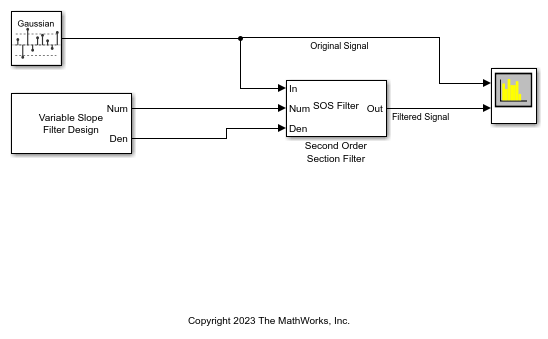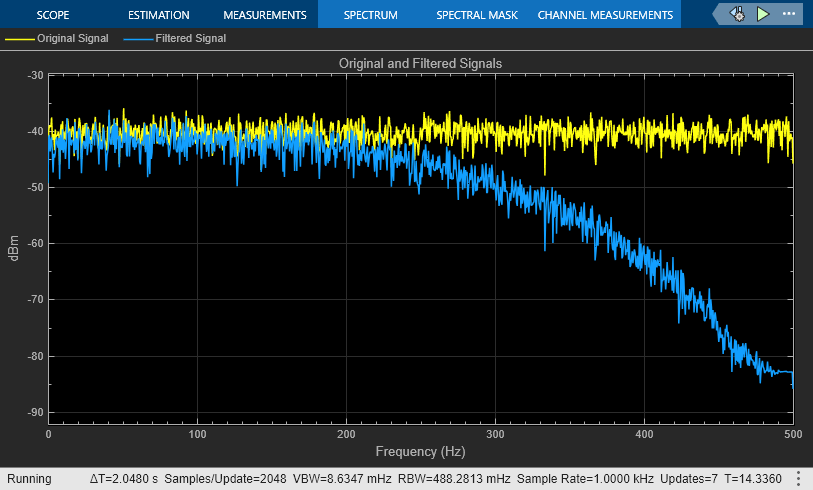Variable Slope Filter Design
Libraries:
Audio Toolbox /
Filters
Description
The Variable Slope Filter Design block designs a lowpass or highpass filter with the specified slope and cutoff frequency. The block outputs filter coefficients of cascaded second-order section (SOS) filters, which you can use with the Second-Order Section Filter block to filter audio signals. You can tune the filter parameters during simulation.
Examples
Use the Variable Slope Filter Design block to design a lowpass filter and pass the coefficients to a Second-Order Section Filter block to filter a signal of random noise. Tune the filter parameters using the dashboard controls and see how the spectrum of the filtered signal changes.


Ports
Input
Use this port to specify the value of the Filter slope parameter.
Dependencies
To enable this port, select the Specify slope from input port parameter.
Data Types: single | double | int8 | int16 | int32 | int64 | uint8 | uint16 | uint32 | uint64
Use this port to specify the value of the Normalized cutoff frequency parameter.
Dependencies
To enable this port, select the Specify normalized cutoff frequency from input port parameter.
Data Types: single | double | int8 | int16 | int32 | int64 | uint8 | uint16 | uint32 | uint64
Use this port to specify the value of the Filter
type parameter; 0 corresponds to a lowpass filter and
1 corresponds to a highpass filter.
Dependencies
To enable this port, select the Specify filter type from input port parameter.
Data Types: single | double | int8 | int16 | int32 | int64 | uint8 | uint16 | uint32 | uint64 | Boolean | enumerated
Output
Numerator filter coefficients, returned as an N-by-3 matrix. N is the number of filter sections and depends on the Maximum filter slope parameter. If Filter slope is less than Maximum filter slope, then the block sets the unused sections to pass-through sections.
Dependencies
The data type of the output depends on the Output data type parameter.
The output dimensions depend on the Maximum filter slope parameter.
Data Types: single | double
Denominator filter coefficients, returned as an N-by-3 matrix. N is the number of filter sections and depends on the Maximum filter slope parameter. A steeper slope requires more filter sections. If Filter slope is less than Maximum filter slope, then the block sets the unused sections to pass-through sections.
Dependencies
The data type of the output depends on the Output data type parameter.
The output dimensions depend on the Maximum filter slope parameter.
Data Types: single | double
Parameters
To edit block parameters interactively, use the Property Inspector. From the Simulink® Toolstrip, on the Simulation tab, in the Prepare gallery, select Property Inspector.
Select this parameter to gradually change a filter parameter to the new value when tuning it. If you clear this parameter, the tuned parameter immediately switches to the new value. Specify the level of smoothing with the Smoothing factor parameter.
Smoothing factor for tuned parameters, specified as a scalar in the range [0,1). As the smoothing factor approaches 1, a tuned parameter changes more gradually to the new value. A smoothing factor of 0 is equivalent to no smoothing.
For more information about smoothing, see Smoothing.
Tunable: Yes
Dependencies
To enable this parameter, select the Smooth tuned filter parameters parameter.
Maximum filter slope in dB/octave, specified as a scalar in the range [0,48]. The Filter slope parameter cannot exceed this value.
When you select this parameter, an additional input port, S, is added to the block.
Filter slope in dB/octave, specified as a scalar in the range [0,48]. The block rounds the slope value to the nearest multiple of 6.
Tunable: Yes
Dependencies
To enable this parameter, clear the Specify slope from input port parameter.
The value of this parameter cannot exceed the value of the Maximum filter slope parameter.
When you select this parameter, an additional input port, Fc, is added to the block.
Normalized cutoff frequency of the filter, specified as a scalar in the range [0,1] where 1 corresponds to the Nyquist frequency.
Tunable: Yes
Dependencies
To enable this parameter, clear the Specify normalized cutoff frequency from input port parameter.
When you select this parameter, an additional input port, T, is added to the block.
Type of filter, specified as lowpass for a lowpass filter
or highpass for a highpass filter.
Data type of output coefficients, specified as double or
single.
Sample time of the block, in seconds, specified as -1 or a
positive scalar. Setting this parameter to -1 means Simulink determines the sample time automatically for you. You can set this
parameter to enable the design block to run at a slower rate than the filtering
block.
Interpreted execution–– Simulate model using the MATLAB® interpreter. This option shortens startup time but has a slower simulation speed thanCode generation. In this mode, you can debug the source code of the block.Code generation–– Simulate model using generated C code. The first time you run a simulation, Simulink generates C code for the block. The C code is reused for subsequent simulations, as long as the model does not change. This option requires additional startup time, but the speed of the subsequent simulations is comparable toInterpreted execution.
Block Characteristics
Data Types |
|
Direct Feedthrough |
|
Multidimensional Signals |
|
Variable-Size Signals |
|
Zero-Crossing Detection |
|
Algorithms
When you select Smooth tuned filter parameters, the Variable Slope Filter Design block uses the following formula to gradually adjust the parameter to the target value when tuning. The block redesigns the filter at each time step with the intermediate parameter values, until the target value is reached.
where:
n is the time step in the simulation.
g is the instantaneous smoothed parameter.
t is the target value for the tuned parameter.
α is the smoothing factor, specified by the Smoothing factor parameter.
References
[1] Orfanidis, Sophocles J. "High-Order Digital Parametric Equalizer Design." Journal of the Audio Engineering Society. Vol. 53, November 2005, pp. 1026–1046.
Extended Capabilities
C/C++ Code Generation
Generate C and C++ code using Simulink® Coder™.
Version History
Introduced in R2024a
See Also
Blocks
Functions
MATLAB Command
You clicked a link that corresponds to this MATLAB command:
Run the command by entering it in the MATLAB Command Window. Web browsers do not support MATLAB commands.
Sélectionner un site web
Choisissez un site web pour accéder au contenu traduit dans votre langue (lorsqu'il est disponible) et voir les événements et les offres locales. D’après votre position, nous vous recommandons de sélectionner la région suivante : .
Vous pouvez également sélectionner un site web dans la liste suivante :
Comment optimiser les performances du site
Pour optimiser les performances du site, sélectionnez la région Chine (en chinois ou en anglais). Les sites de MathWorks pour les autres pays ne sont pas optimisés pour les visites provenant de votre région.
Amériques
- América Latina (Español)
- Canada (English)
- United States (English)
Europe
- Belgium (English)
- Denmark (English)
- Deutschland (Deutsch)
- España (Español)
- Finland (English)
- France (Français)
- Ireland (English)
- Italia (Italiano)
- Luxembourg (English)
- Netherlands (English)
- Norway (English)
- Österreich (Deutsch)
- Portugal (English)
- Sweden (English)
- Switzerland
- United Kingdom (English)